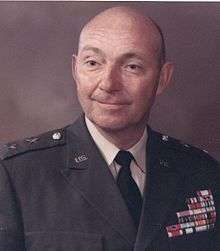Phillip Davidson
| Phillip Buford Davidson, Jr. | |
|---|---|
 | |
| Born |
November 26, 1915 Hachita, New Mexico |
| Died |
February 7, 1996 (aged 80) San Antonio, Texas |
| Place of burial | Arlington National Cemetery |
| Allegiance |
|
| Service/branch |
|
| Years of service | 1939-1974 |
| Rank |
|
| Battles/wars |
World War II Korean War Vietnam War |
| Awards |
Distinguished Service Medal Silver Star Legion of Merit (3) Bronze Star Medal Purple Heart |
| Other work | author |
Phillip Buford Davidson, Jr. (November 26, 1915 – February 7, 1996) was an American lieutenant general, who served in World War II, the Korean War, and the Vietnam War.
Biography
Davidson was born on November 26, 1915 in Hachita, New Mexico. Davidson attended West Point, graduating in 1939. During World War II, he served as assistant intelligence officer in the 96th Infantry Division. Later, he served as a squadron commander in George Patton's Third Army.[1]
Following the War, he was assigned as an instructor to the Army's School of Intelligence in Fort Leavenworth, Kansas.
Starting in 1948 and continuing throughout the Korean War, Davidson was chief, Plans and Estimates Branch, in General Douglas MacArthur's intelligence office. It was during this time that occurred one of the US Army's greatest intelligence failures in history - the failure to predict Chinese entry into the Korean war.
In 1969, while assigned as commanding General of the Army training center at Fort Ord, California, Davidson was the respondent in the United States Supreme Court decision Parisi v. Davidson. In that case, the court granted habeas relief to a soldier seeking an honorable discharge as a conscientious objector.
During the Vietnam War, 1967 until 1969, Davidson was the chief of US intelligence in Vietnam, under the command of William Westmoreland and later Creighton Abrams. From May 3, 1971 to September 30, 1972, Davidson, then a Major General, was the Assistant Chief of Staff for Intelligence, Headquarters, Department of the Army. He later was promoted to Lieutenant General.[2]
In 1988, he published Vietnam at War: The History 1946-1975,[3] which is widely regarded as one of the most comprehensive accounts of the Indochina wars.[4] He followed it up in 1990 with Secrets of the Vietnam War,[5] where he described his experiences in Vietnam.
Davidson died February 7, 1996 in San Antonio, Texas. He is buried in Arlington National Cemetery.
Davidson is a member of the Military Intelligence Hall of Fame.
Military decorations
Lieutenant general Davidson received a lot of decorations during his military service.[6] Here is the list:
See also
References
- ↑ West Point Class of 1939: Phillip B. Davidson, Jr.
- ↑ Tucker, Spencer. Encyclopedia of the Vietnam War: A Political, Social, and Military History. Santa Barbara, Calif: ABC-CLIO, 1998, p. 262.
- ↑ Davidson, Phillip B. Vietnam at War: The History, 1946-1975. Novato, Calif: Presidio Press, 1988. ISBN 0195067924
- ↑ Jonathan Mirsky. Reconsidering Vietnam, The New York Times Review of Books, October 10, 1991.
- ↑ Davidson, Phillip B. Secrets of the Vietnam War. Novato, CA: Presidio, 1990. ISBN 0891413820
- ↑ Hall of Valor: Phillip Buford Davidson , Jr.
